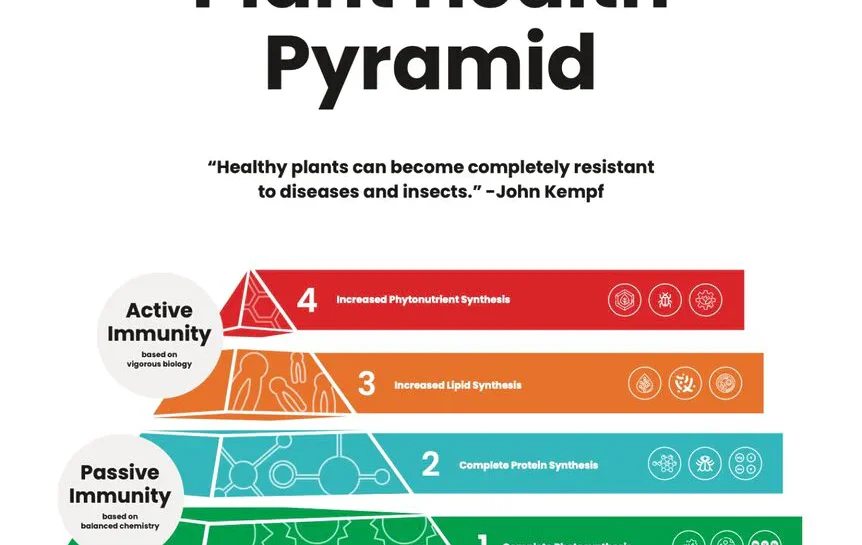Maximizing Yield Through Strategic Plant Nutrition: The Four Levels of Plant Health

Most farmers are leaving money on the table. Not because they’re doing anything wrong, but because they’re accepting “normal” plant performance as optimal. What if I told you that most crops are photosynthesizing at only 25% of their genetic capacity? That’s not a production problem—that’s a massive opportunity.
After working with thousands of growers, we’ve identified four distinct levels of plant health that directly correlate with yield potential and input costs. Understanding these levels can help you make strategic nutrition decisions that pay dividends in both bushels per acre and reduced pest pressure.
Level 1: Unlocking Photosynthetic Potential
The Goal: Complete photosynthesis – both quantity and quality of sugar production
The Payoff: 3-4x increase in sugar production, measurable through brix readings
Here’s what most people don’t realize about photosynthesis – it’s not just about sunlight and water. You need five specific minerals working in harmony:
- Magnesium – Core component of chlorophyll
- Nitrogen – Critical for chlorophyll synthesis
- Iron – Essential for chlorophyll assembly
- Manganese – Required for water hydrolysis (the first step in photosynthesis)
- Phosphorus – Powers ATP production to metabolize all those extra sugars
The fascinating part? You can measure this in the field. A properly photosynthesizing plant will show brix readings of 12-15, compared to the typical 3-5 you see in most crops. That’s not just a number – that’s stored energy the plant can use for growth, reproduction, and defense.
The practical challenge: Iron and manganese oxidize easily in soil, so even if your soil tests show adequate levels, they might not be plant-available. This is why foliar applications often work better than soil applications for these micronutrients.
Level 2: Protein Synthesis and Natural Pest Control
The Goal: Convert all nitrogen forms into complete proteins
The Payoff: Resistance to sucking and larval insects within 24-48 hours
This is where the magic happens from a pest management perspective. When plants efficiently convert nitrates into proteins, they remove the food source for aphids, thrips, whiteflies, and other soft-bodied insects. These pests literally can’t digest complete proteins – they need simple nitrates.
You can verify this is working through sap analysis. A healthy Level 2 plant will show zero nitrates and ammonium in the sap test, but abundant total nitrogen. The insects show up, find nothing to eat, and move on to someone else’s field.
Required minerals for Level 2:
- Magnesium – Enzyme activation
- Sulfur – Amino acid synthesis
- Molybdenum – Nitrogen fixation and reduction
- Boron – Protein synthesis and pest resistance
The timeline here is crucial for spray timing. Unlike systemic insecticides that take days to work, proper mineral nutrition can shift protein synthesis within hours.
Level 3: Energy Storage and Disease Resistance
The Goal: Surplus energy storage as lipids (plant fats)
The Payoff: 2-4x increase in lipid production, natural fungicide properties
This is where plant health becomes visually obvious. You’ll see glossy, waxy leaves that aren’t just cosmetic – they’re functional armor. That waxy coating prevents fungal pathogens from using their pectolytic enzymes to break into leaf cells.
But here’s the key insight: reaching Level 3 requires shifting from chemical inputs to biological nutrition. Plants need to get most of their nutrition from soil microbes, not synthetic fertilizers. Why? Because microbial metabolites are “prefabricated parts” – complex compounds that save the plant energy.
Consider this: when corn gets 80% of its nitrogen as nitrates, it burns 16% of its total energy converting those nitrates to amino acids. But if soil microbes provide pre-made amino acids, that 16% gets redirected to lipid storage and defense compounds.
The management shift: This level requires focusing on soil biology, not just chemistry. You’re managing an ecosystem, not just plant nutrition.
Level 4: Maximum Defense and Yield Stability
The Goal: Elevated secondary metabolite production
The Payoff: Resistance to chewing insects, nematodes, and even some viruses
Level 4 plants produce pharmaceutical-grade compounds – the same secondary metabolites we extract for medicines. These aren’t just pest deterrents; they’re broad-spectrum defense compounds that can handle everything from Japanese beetles to root rot nematodes.
The business case here is yield stability. Level 4 plants don’t just produce more – they produce consistently, even under stress. We’ve seen viral expression become dormant in these plants, meaning the virus is present but has no effect on yield.
Requirements: A diverse, disease-suppressive microbiome both above and below ground. This triggers the plant’s immune responses (SAR and ISR) and ramps up secondary metabolite production.
The Practical Implementation Strategy
Start with the foundation: Most operations should focus on getting to Level 2 consistently before chasing Level 3 or 4. The first two levels can be achieved through strategic foliar nutrition – you’re solving chemistry problems.
Key monitoring tools:
- Brix readings for photosynthetic efficiency
- Sap analysis for nitrogen conversion
- Visual assessment for lipid production
- Pest pressure as a diagnostic tool
Economic reality: The ROI is strongest in Levels 1 and 2 because you can achieve them with targeted foliar applications. Levels 3 and 4 require longer-term soil biology investments, but they offer the greatest yield stability benefits.
Timing considerations: The beauty of this approach is that insect resistance can kick in within 24-48 hours of proper mineral application. That’s faster than most chemical controls and without the resistance issues.
The Bottom Line
This isn’t about organic versus conventional – it’s about understanding how plants actually work and optimizing their performance. When you give plants what they need nutritionally, they handle pest and disease pressure naturally while producing more per acre.
The farmers seeing the biggest wins are those who approach this systematically, level by level, using both chemistry and biology to maximize plant genetic potential. It’s not just about growing crops – it’s about growing crops that can defend themselves while hitting yield targets you didn’t think were possible.
Ready to see what your crops are really capable of? Start with Level 1 – get those five minerals dialed in and watch your brix readings climb. Everything else builds from there.
